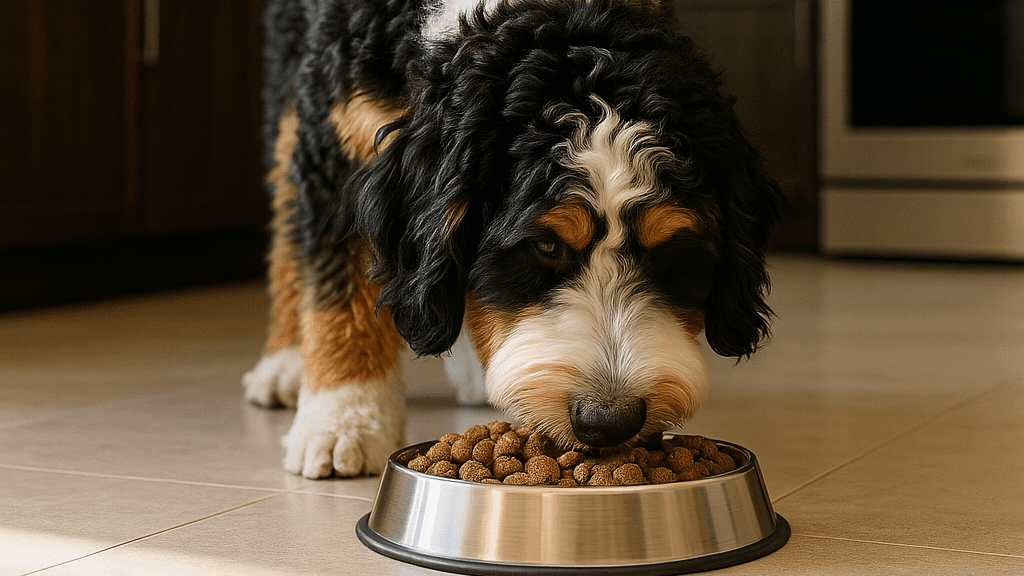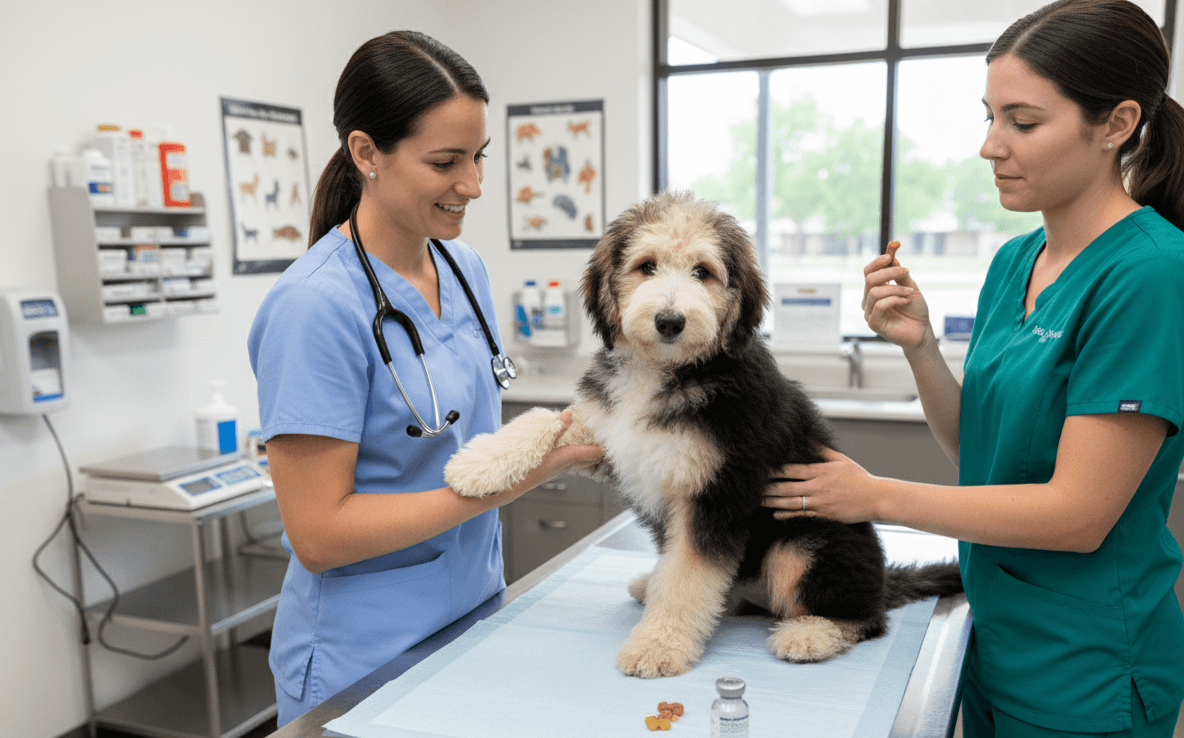
Bernedoodle Nutrition 101: Choosing the Right Diet for Your Dog
By Harpers Ferry Doodles · 7/23/2025 · 🕒 4 min read
A healthy diet for a large breed dog like a Bernedoodle should include high-quality protein to support muscle development, healthy fats for energy and coat health, and the right balance of vitamins and minerals for overall wellness. Puppies have different nutritional needs than adults—they’re growing fast and need more calories, protein, and fat to fuel development, while adults require a more balanced formula to maintain weight and long-term health. Feeding your Bernedoodle the right food at each life stage can help prevent issues down the road and keep them happy, active, and thriving!
So what is the right food? With hundreds of options, sometimes making the right choice can seem overwhelming. Two of the most common options for dog owners today are traditional dry kibble and fresh or raw food diets. Each comes with its own benefits and trade-offs, and what works best often depends on your dog’s needs, your lifestyle, and your budget. Here's a breakdown to help you compare:
🦴 Dry Dog Kibble | |
|---|---|
✅ Pros: • Convenient and shelf-stable – easy to store, scoop, and serve. • More affordable than fresh/raw diets. • Widely available in stores and online. • Often fortified with vitamins, minerals, and joint-supporting supplements. • Good for dental health (crunching can help reduce plaque buildup). | ❌ Cons: • May include low-quality ingredients, fillers, or artificial additives. • Less moisture content, which can contribute to dehydration (especially if dogs don’t drink enough). • Can be harder to digest for dogs with sensitive stomachs. • Nutrient bioavailability may be lower compared to fresh food. • Picky eaters may lose interest quickly. |
🥩 Fresh or Raw Dog Food | |
✅ Pros: • Highly digestible, with better nutrient absorption. • Often leads to shinier coat, better breath, and smaller, firmer stools. • Fewer additives and preservatives – closer to a dog’s natural diet. • Can be tailored to specific health needs (e.g., allergies, joint support). • Picky dogs often find it more palatable and exciting.
| ❌ Cons: • More expensive than kibble, especially for large breeds. • Requires refrigeration or freezing, and more prep time. • Risk of imbalanced nutrition if not properly formulated. • Raw food carries potential safety risks if not handled or sourced carefully. • Transition period can cause digestive upset if done too quickly. |
Kibble: What to look for in a brand
When choosing a kibble for your Bernedoodle, it’s important to look past the marketing and focus on the ingredient list. Start by avoiding red flag ingredients like meat by-products, generic "animal" meals, artificial colors (like Red 40 or Yellow 5), chemical preservatives (such as BHA, BHT, and ethoxyquin), and added sweeteners like corn syrup. These can be signs of a lower-quality food that may cause digestive issues or allergic reactions. Instead, look for brands that list a named animal protein (like chicken, beef, or salmon) as the first ingredient, include whole grains or grain-free complex carbs (like brown rice or sweet potato), and feature beneficial extras like omega-3 fatty acids, probiotics, and glucosamine for joint support. A high-quality kibble should be transparent about its sourcing and nutritional standards—don’t be afraid to research the brand and read reviews.
We personally use Wellness Complete Health for our dogs because it checks all those boxes. It’s made with high-quality, recognizable ingredients, supports whole-body health, and offers excellent value without breaking the bank. It’s a great choice for families who want to feed their dog well without going to extremes.
Fresh or Raw Dog Food
Fresh and raw diets are becoming increasingly popular among dog owners looking for more natural, minimally processed nutrition. These options often contain real meat, vegetables, and healthy fats without unnecessary fillers or preservatives. Many owners report improvements in coat shine, digestion, and overall energy levels after switching. While they require more storage and preparation, there are now many fresh and raw dog food delivery services that make feeding this way much easier and safer. One we love and recommend is Buck Wild Bison Dog Food—it’s rich in protein, free from artificial additives, and dogs absolutely love the taste. Use code HFDOODLES at checkout for an exclusive discount. Always make sure the meals are balanced or consult your vet to avoid nutritional gaps.
Portion Control
For many families, the best feeding approach is a balanced mix of high-quality kibble and fresh or raw food. No matter what blend you choose, portion control plays a big role in your Bernedoodle’s long-term health. This includes not overdoing it with treats and table food. Overfeeding—especially in large breeds—can lead to weight gain, joint stress, and other preventable issues. Always follow the feeding guidelines on your dog food and adjust based on your dog’s activity level, age, and metabolism.
Final Thoughts
Choosing the right diet for your Bernedoodle doesn’t have to be overwhelming. Whether you go with a high-quality kibble, fresh or raw food, or a balanced mix of both, the goal is to support your dog’s health, energy, and longevity. Start by learning to read ingredient labels, watch out for red flags, and focus on whole, nutritious foods that meet your dog’s needs. Every pup is different, so pay attention to how your dog responds and don’t be afraid to make adjustments. When in doubt, consult your vet—and remember, a well-fed dog is a happy dog!
Keep Reading

Oct 7, 2025
How to Keep Your Bernedoodle’s Coat Tangle-Free Between Groomer Visits
Keep your Bernedoodle’s coat tangle-free between grooms with the right tools, simple brushing techniques, and an easy routine.

Sep 25, 2025
Giving Puppies the Best Start: ENS and ESI Explained
We use Early Neurological Stimulation (ENS) and Early Scent Introduction (ESI) to give our puppies a stronger start in life—building healthier bodies, sharper minds, and confident temperaments.

Sep 5, 2025
Vaccination & Vet Care Checklist for Your Puppy’s First Year
A month-by-month guide to your puppy’s first year of veterinary care — including vaccines, deworming, and preventive health tips to set them up for a lifetime of wellness.